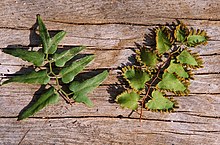| Lygodium microphyllum | |
|---|---|

| |
| Underside of spore-bearing leaflets, some leaflets produce spores; others do not. | |
| Scientific classification | |
| Kingdom: | Plantae |
| Clade: | Tracheophytes |
| Division: | Polypodiophyta |
| Class: | Polypodiopsida |
| Order: | Schizaeales |
| Family: | Lygodiaceae |
| Genus: | Lygodium |
| Species: | L. microphyllum
|
| Binomial name | |
| Lygodium microphyllum | |

| |
| Global distribution[4] | |
| Synonyms[3][5][6] | |
Lygodium microphyllum (commonly known as, variously, climbing maidenhair fern,[3] Old World climbing fern,[3] small-leaf climbing fern,[3] or snake fern[3]) is a climbing fern originating in tropical Africa, Southeast Asia, Melanesia and Australia.[3] It is an invasive weed[7] in Florida[8] where it invades open forest and wetland areas. The type specimen was collected in the vicinity of Nabúa, on the island of Luzon in the Philippines by Luis Née.[9]
- ^ Irudayaraj, V. (2011). "Lygodium microphyllum". IUCN Red List of Threatened Species. 2011: e.T194153A8883960. Retrieved 8 November 2022.
- ^ NatureServe (3 November 2023). "Lygodium microphyllum". NatureServe Network Biodiversity Location Data accessed through NatureServe Explorer. Arlington, Virginia: NatureServe. Retrieved 26 November 2023.
- ^ a b c d e f g Under its treatment as Lygodium microphyllum (from its basionym of Ugena microphylla), this species name was published first in Prodromus Florae Novae Hollandiae 162. 1810. "Lygodium microphyllum". Germplasm Resources Information Network. Agricultural Research Service, United States Department of Agriculture. Retrieved November 2, 2011.
- ^ Volin, John C.; Kruger, Eric L.; Volin, Valeria C.; Tobin, Michael F.; Kitajima, Kaoru (2009). "Does release from natural belowground enemies help explain the invasiveness of Lygodium microphyllum? A cross-continental comparison". Plant Ecology. 208 (2): 223. doi:10.1007/s11258-009-9700-6. S2CID 38267539.
- ^ Ugena microphylla, the basionym of L. microphyllum, was first described and published in Icones et Descriptiones Plantarum 6: 76, pl. 595, f. 2. 1801. "Ugena microphylla". Germplasm Resources Information Network. Agricultural Research Service, United States Department of Agriculture. Retrieved November 2, 2011.
- ^ "Name - Ugena microphylla Cav. synonyms". Tropicos. Saint Louis, Missouri: Missouri Botanical Garden. Retrieved November 2, 2011.
- ^ "Global Fire Initiative: Fire and Invasives". The Nature Conservancy. Archived from the original on 2009-04-12. Retrieved 2008-12-12.
- ^ Soti, Pushpa G.; Jayachandran, Krish; Koptur, Suzanne; Volin, John C. (2015). "Effect of soil pH on growth, nutrient uptake, and mycorrhizal colonization in exotic invasive Lygodium microphyllum". Plant Ecology. 216 (7): 989–998. doi:10.1007/s11258-015-0484-6. S2CID 17894584.
- ^ "Name - Ugena microphylla Cav". Tropicos. Saint Louis, Missouri: Missouri Botanical Garden. Retrieved November 2, 2011.

